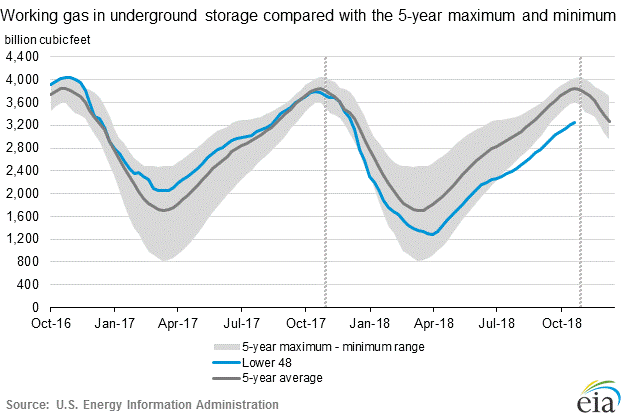Natural gas prices skyrocketed this week, shooting above $4.80 per MMBtu on Wednesday, a price last seen during the polar vortex of 2014.
Low gas inventories are leaving the market on edge, and volatility has roared back to the market. In this column only a week ago, I marveled at prices soaring to $3.50/MMBtu, which marked a 15 percent increase over the prior two months. However, in the last seven days, prices are up a further 30 percent.
The factors behind the price increase are the same as they have been for quite a while now. U.S. natural gas inventories are at a 15-year low for this time of year, just as we head into the winter drawdown season. U.S. natural gas inventories stood at 3,247 billion cubic feet (Bcf) for the week ending on November 9, or 528 Bcf less than at this point in 2017, and 601 Bcf below the five-year average. In other words, the U.S. has a thin buffer of storage to fall back on in the event of a sudden bout of cold weather.

(Click to enlarge)
And it is exactly that variable that helped spark the most recent rally in prices. Reports that cold weather has arrived in much of the U.S. already, plus indications that the upcoming winter could be an unusually cold one, helped fuel this week’s rally. Natural gas had traded below $3/MMBtu for much of this year, but climbed roughly 50 percent since mid-September.
Just a few weeks ago, Bank of America Merrill Lynch said that given the backdrop of a 15-year low for inventories, any unexpected cold weather could push prices up as high as $5/MMBtu. That may have looked a little aggressive at the time, but now appears rather prescient.
A few other factors have played their part. “[E]arly-season cold, production freeze-offs, and the ramp up of exports from Corpus Christi – have shocked the gas market in ways not seen since the Polar Vortex winter of 2013/14,” Barclays said in a note.
The bank estimates that since the weekend, freeze-offs have disrupted about 2 Bcf/d of pipeline flows, about three-quarters of which came in Texas. These disruptions could extend into next week. Skyrocketing associated gas production in the Permian heightens the potential disruption to supply from freeze-offs. Related: Canadian Oil Producer Calls For Production Cap Amid Record Low Prices
Finally, trader positioning also played a role in Wednesday’s price spike. Prices broke through technical resistance levels over the last few days and traders likely closed out short positions en masse, driving prices higher.

What happens next? The only certainty is that prices in the short run will be volatile. On Wednesday, prices spiked to $4.80/MMBtu. But by Thursday, prices crashed again, falling by more than 15 percent. The EIA’s storage data showed a slight build in inventories, taking some of the steam out of Wednesday’s panicked buying spree.
But the small cushion of storage still leaves the U.S. market highly vulnerable to additional price spikes. As we saw in 2014, when the polar vortex temporarily pushed prices above $7/MMBtu, extreme cold weather can entirely upend even the most careful price forecast.
“2018 has been a year of weather extremes in the US, including the coldest April in 35 years, the hottest May-Sept on record, and the first colder-than-normal Oct in 9 years,” Morgan Stanley said in a note. “November is following the trend, with the current forecast one of the coldest since 2000.”
The dip in the mercury means that power plants are ramping up to provide heating for much of the country, which could further slice into inventories.
But as we saw Thursday, price spikes can go too far. Barclays warned about this in a note just after Wednesday’s rally, anticipating Thursday’s price correction. “[B]ulls could not have hoped for better weather to start the winter,” the investment bank wrote on Thursday. The bank argued that the price spike is likely temporary. “A regression to the mean poses real downside risks to prices,” Barclays warned. A few hours after that report was published, prices began to crash. Related: A New Era For Mexican Energy
Morgan Stanley also got ahead of the price correction. “We see modest downside from here assuming current weather forecasts, but a very wide range of potential short-term prices,” Morgan Stanley said in a note. The investment bank says that with Henry Hub prices north of $4/MMBtu, they have “now modestly over-corrected to the upside.”
ADVERTISEMENT
The market looks tight now, but heading into next year, the shortages should clear up. “Beyond this winter, we continue to see structural oversupply,” Morgan Stanley wrote.
Other analysts generally agree on this point. “[R]ecord-high US natural gas production points to a brief (and expensive) intermezzo, especially as the high price should dampen demand from electricity providers,” Commerzbank said in a November 15 note.
While most forecasters see the price spikes as temporary, the next few weeks and months will likely be characterized by high volatility. “NYMEX has posted large jumps of 28¢, 31¢, and more than 50¢ in the past eight sessions, and implied volatility has increased to its highest level since at least 2010,” Barclays said.
By Nick Cunningham of Oilprice.com
More Top Reads From Oilprice.com:
- Can OPEC Halt An Oil Market Meltdown?
- Significant Crude Build Weighs On Oil Markets
- Natural Gas Skyrockets As China Pledges Huge Supply Boost



















It seems the weather is more "justification" for the pricing than there actually is any need given they could just stop exports for the winter to more than offset any "threat" to "low" inventories. We do not exist in a market which is driven by fundamentals.